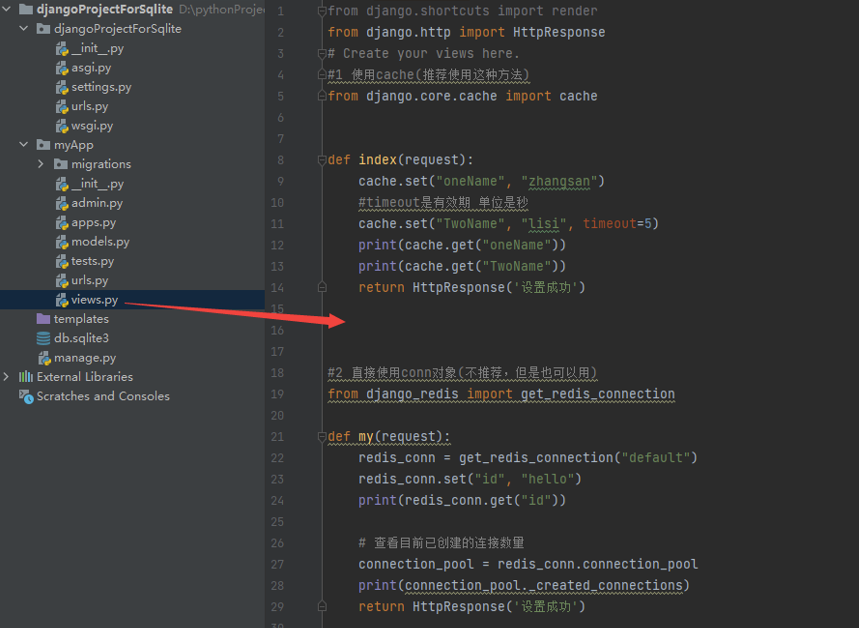Django操作redis
一、环境安装
基本环境:
Python环境:Python 3.8.16
Django环境:4.1
redis环境:参考搭建 https://www.cnblogs.com/yclh/p/14742336.html
并且已经添加了myApp的应用
安装redis的包:
pip install django-redis
二、配置文件
打开Django的配置文件,比如说setting.py,里面设置CACHES项
CACHES = {
"default": {
"BACKEND": "django_redis.cache.RedisCache",
"LOCATION": "redis://127.0.0.1:6379",
"OPTIONS": {
"CLIENT_CLASS": "django_redis.client.DefaultClient",#连接池
"CONNECTION_POOL_KWARGS": {"max_connections": 100},#连接池
"SOCKET_CONNECT_TIMEOUT": 5, # 连接redis超时时间,单位为秒
"SOCKET_TIMEOUT": 5, # redis读写操作超时时间,单位为秒
# "PASSWORD": "123",
}
}
}
三、myApp里配置路径和编写view的方法
1、配置路径

2、编写view的方法

1 2 3 4 5 6 7 8 9 10 11 12 13 14 15 16 17 18 19 20 21 22 23 24 25 26 27 28 29 | from django.shortcuts import renderfrom django.http import HttpResponse# Create your views here.#1 使用cache(推荐使用这种方法)from django.core.cache import cachedef index(request): cache.set("oneName", "张三") #timeout是有效期 单位是秒 cache.set("TwoName", "lisi", timeout=5) print(cache.get("oneName")) print(cache.get("TwoName")) return HttpResponse('设置成功')#2 直接使用conn对象(不推荐,但是也可以用)from django_redis import get_redis_connectiondef my(request): redis_conn = get_redis_connection("default") redis_conn.set("id", "hello") print(redis_conn.get("id")) # 查看目前已创建的连接数量 connection_pool = redis_conn.connection_pool print(connection_pool._created_connections) return HttpResponse('设置成功') |
四、验证效果
注:结合控制台的输出,验证从redis里取数据
1、进入redis客户端
127.0.0.1:6379> keys *
(empty list or set)
没有主键信息
2、浏览器访问http://127.0.0.1:8000/redis/test
127.0.0.1:6379> keys *
1) ":1:TwoName"
2) ":1:oneName"
有两个key了,过5秒钟在次查看
127.0.0.1:6379> keys *
1) ":1:oneName"
TwoName过期就从redis里自动删除了
3、浏览器访问http://127.0.0.1:8000/redis/other
127.0.0.1:6379> keys *
1) "id"
2) ":1:oneName"
说明view里写的两种方式都可以操作redis




【推荐】国内首个AI IDE,深度理解中文开发场景,立即下载体验Trae
【推荐】编程新体验,更懂你的AI,立即体验豆包MarsCode编程助手
【推荐】抖音旗下AI助手豆包,你的智能百科全书,全免费不限次数
【推荐】轻量又高性能的 SSH 工具 IShell:AI 加持,快人一步
· 被坑几百块钱后,我竟然真的恢复了删除的微信聊天记录!
· 没有Manus邀请码?试试免邀请码的MGX或者开源的OpenManus吧
· 【自荐】一款简洁、开源的在线白板工具 Drawnix
· 园子的第一款AI主题卫衣上架——"HELLO! HOW CAN I ASSIST YOU TODAY
· Docker 太简单,K8s 太复杂?w7panel 让容器管理更轻松!